 |
Scientific nameScutellista caerulea (Boyer de Fonscolombe) (=Scutellista cyanea Motschulsky)
Taxonomic positionHymenoptera: Chalcidoidea: Pteromalidae: Eunotinae
DiagnosisFemale: Body brilliant metallic bluish-purplish, robust, in lateral view slightly hump-backed or dumpy. Head broader than long, posteriorly acutely margined. Antenna 8-segmented. Dorsal side of thorax with reticulations between hairs. Scutellum elytriform and produced as a flat roof over propodeum, extending as far as first abdominal tergite. Fore wing, including basal portion, entirely pilose / hairy.
Male: Similar to female, except scutellum not so enlarged as in female. Antenna 7-segmented with distinct sensillae. This species can be readily identified by the brilliantly metallic purplish body and the very broad and elongate elytriform scutellum in female extending well beyond the anterior portion of gaster (abdomen). 
 Antenna - female (left) and male (right) Antenna - female (left) and male (right)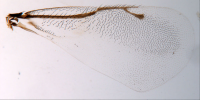 Forewing (female) Forewing (female)
Images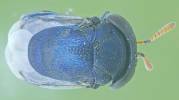
 Adult, dorsal view - female (left) and male (right) Adult, dorsal view - female (left) and male (right)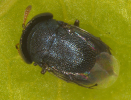

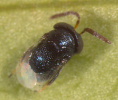
 Adult - dorsal view Adult - dorsal view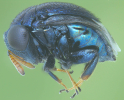
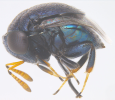

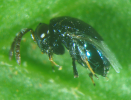 Adult female and male - lateral view Adult female and male - lateral viewDistribution
India: Widely distributed (recorded from Gujarat, Karnataka, Maharashtra and Tamil Nadu). Widely distributed in the Oriental region; Australasia; Europe; South and North Africa; America.
HostsThe larvae are predators of eggs and crawlers of several species of Coccoidea (mainly Coccidae) such as Saissetia nigra, S. coffeae, S. oleae, Ceroplastes spp., Coccus hesperidum, Cerococcus hibisci and several other hosts.
See Universal Chalcidoidea Database for complete list of hosts and associated plants. Viggiani (1997) provided a summary of the diagnostic and biological details available on S. caerulea. References
|
